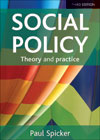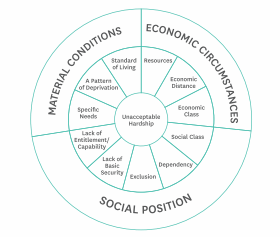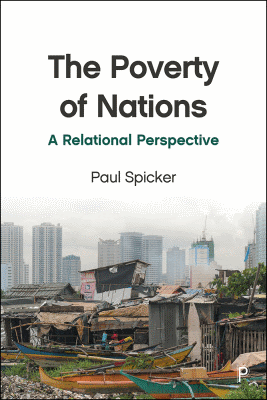
Paul Spicker
Poverty
The idea of poverty
There is no generally agreed definition of poverty. This is because,
Piachaud argues, the definition of poverty is a moral question - it
refers to hardship which is unacceptable. [1] 'Poverty' may
refer to:

- material conditions - needing goods and services,
multiple deprivation, or a low standard of living;
- economic position - low income, limited resources,
inequality or low social class; and
- social position of the poor, through lack of
entitlement, dependency or social exclusion.
The chart points to a range of different meanings: some are close to
each other, others far apart.
Poverty has often been described
in terms of low income and resources, but this does not capture the
huge range of issues which it touches. The
World Bank’s study, Voices of the
Poor, identifies several recurring themes. In relation to
material conditions, there are precarious livelihoods, problems of
physical health and living in excluded locations. The studies put
great emphasis on social relationships - relationships of gender,
social exclusion and lack of security. And then there are
political issues - limited abuse of
authority by those in power. [2] These issues cannot be set
aside in trying to deal with poverty, and poverty is
increasingly being thought of as a multidimensional concept.
External links: Voices
of the Poor | (PDF) | Poverty in the UK | Poverty
- an International Glossary (PDF)
Poverty in a social
context
Conventionally, poverty is represented in
two main models.
- Absolute poverty is based on subsistence, a minimum
standard needed to live. Seebohm Rowntree's research identified a
'poverty line' on the basis of minimum needs. [3] The Copenhagen
Declaration defines absolute poverty as "a condition characterised by
severe deprivation of basic human needs, including food, safe drinking
water, sanitation facilities, health, shelter, education and
information. It depends not only on income but also on access to social
services." [4]
- Relative poverty is based on a comparison of poor
people with others in society. Peter Townsend defines poverty as "the
absence or inadequacy of those diets, amenities, standards, services
and activities which are common or customary in society." [5]
Poverty, like all need, is defined in terms of the society where it
takes place: what people can eat, and where they can live, depend on
the society they live in. That does not mean that it is based
only on a
comparison with others in the same society; there are some countries
where most people are poor. Beyond that, social and political
relationships - like problems of gender or relationships to authority -
are an integral part of the experience of poverty. These issues
occur in many different societies, in poorer and richer countries
alike, but they can only be
understood in their social context.
The causes of poverty
The problems of poverty have been explained in many ways.
Pathological explanations are those which attribute poverty to the
characteristics or behaviour of poor people. They include:
- individualistic explanations. Poor people are assumed to
be inadequate, to have made bad choices, or to have chosen their
lifestyle.
- familial. Poverty is believed to run in families, with
the transmission of inadequate behaviour from one generation to the
next. (This proposition has been thoroughly researched; it is not true.
[6])
- sub-cultural views. The 'culture of poverty' suggests
that poor people learn to be different, and 'adapt' to poverty. The
evidence here is ambiguous, and much disputed.
Structural explanations explain poverty in terms of the
society where it occurs. They include:
- class-based explanations. Poverty is the result of some
people's marginality in relation to the process of economic production,
which limits their life-chances.
- 'agency' views. Poverty is attributed to the failures of
public services.
- inequality. Poverty is attributed to inequalities in
the structure of society, which lead to denial of opportunity and
perpetuation of disadvantage. Examples are the inequalities of income,
wealth, race, and gender.
Further material: Social
problems | Welfare and equality
External link: Paul Spicker (this website's author)
talks to the BBC about the transmission of poverty
Measuring poverty
Because there is no agreed definition of poverty, there can be no
agreed measure. Even if definitions were agreed, though, poverty would
be complex and difficult to quantify. Measures of poverty have to be
'indicators', or signposts. The most commonly used measure is based on
income. The World Bank, for example, used to use the arbitrary standard
of $1.25 per day; at this level there are about 1300 million poor
people in the world. At $2 a day, another arbitrary line, the figure
approaches 2.5 billion.
Some nations apply 'budget standards', estimating the cost of a
minimum basket of goods. The US defines its poverty threshold by
identifying the cost of a food basket and estimating from that how much
income is necessary. Others use relative measures. The European Union
uses a comparative indicator which defines people as being 'at risk of
poverty' if their income is below 60% of the median income. (The median
comes half-way up the income distribution). This means that there is
more poverty where there is more inequality, or 'economic distance'.
Social science surveys have estimated the numbers of poor people in
various ways. Some use budget standards; others use a 'subjective'
poverty test, to see whether people identify themselves as poor. Others
again have developed a 'consensual' method, where an opinion poll is
used to identify what people in that society see as essential, and
working from there to see who can afford that standard. A survey for
the Joseph Rowntree Foundation estimates that on these tests a quarter
of Britain's population is poor. [7]
External links: World
Bank | US Poverty Threshold | Rowntree survey | Madden: The Heart of Poverty
Targeting the poor
Providing services to poor people often depends on the idea that it
is possible to 'target' resources or services by choosing the people
who will receive them. In principle, people should receive benefits and
services when they are poor,
and they should not receive them when they are not. There are many
problems with this in practice.
- Identifying incomes is difficult. Incomes can change rapidly and
the process can be inaccurate.
- There are always problems at the boundaries. Having a
cut-off at a specified threshold leads to unfairness (because
someone just below will then be better off than someone just above),
but withdrawing benefits gradually leads to a 'poverty trap' which
penalises people for improving their situation.
- The barriers mean that the services generally fail to reach many
people the services are intended for.
- The process is administratively difficult and costly.
Because governments
lack the capacity to test income effectively, some are using 'proxy'
means tests, based on an analysis of national studies of households.
Indicators are chosen which seem most likely to be associated with low
income and poverty. These tests are easier and cheaper to run
than full tests of income, and the information about whether people
have basic assets is likely to be more stable. However, the World
Bank has found that "it is hard to add new beneficiaries in the short
term and hard to remove them from the program rosters when a crisis has
passed." [8]
Proxy means tests appear to be better at excluding people who are not
poor than they are at identifying and including those who are.[9] The
process is very approximate, which defeats the purpose of
trying to fit the response to individual needs. It can seem arbitrary -
some claimants tend to think it is decided almost as a matter of luck,
some pray for success - and,
Australian Aid has argued, there are openings for corruption, as people
pay bribes to get on the rolls. [10]
The World Bank has also examined 'indicator targeting', trying to
reach the poor by focusing on associated factors. It may be done, for
example, by concentrating on
areas affected by drought or crop failure; subsidies for
particular foods can be chosen in order to benefit poor people.
However, focusing on geographical areas has not proved effective.
Sometimes universal services, like Essential
Health Care Packages, are better at getting resources to poor people
than selective services are.
Further material: Targeting;
Universality and
selectivity
External reading: Hit and Miss
Policies for poverty
Poverty can be responded to in many ways:
- Poor relief. Where
people are poor, they can be given specific help. This can be
done by simply asking people to come for help, which is how a soup
kitchen works; it is more usually done by some form of selective
provision. Poor relief is not a cure for poverty, but it is
important for people to survive.
- Provision for contingencies.
Most systems of social protection work by protecting people in
circumstances where they might otherwise come to be poor - old age,
disability, unemployment and so on. This has been more
effective than focusing directly on poor relief, but necessarily it
can only deal with part of the issues.
- Indirect responses.
Sometimes policies that are not aimed at reducing poverty directly can
help to
reduce it, or to mitigate its effects. Examples are improving
health, protecting women's rights and reducing corruption.
- Strategic intervention.
Many people believe that the problems of poverty can be solved by
focusing on selected key issues - such as education, child
rearing or investing in communities. Poverty is rather too
complex, and relates to too many problems, for this to be
true.
- Prevention. It is
often argued that prevention is cheaper than cure. However,
prevention depends on knowing what circumstances lead to poverty.
Social issues are multi-faceted and
intertwined, and in most cases, the confident assertions that
people have made about causes - genetic inheritance, dysfunctional
families, educational opportunity or benefits systems - have proved to
be wrong.
Any well-designed strategy to deal with a multidimensional set of
issues depends on a range of policies being implemented together, and
Poverty Reduction Strategies generally combine issues of economic and
human development with issues of governance. The most
effective responses to poverty have probably been
- economic
development, because it improves the conditions of many people
at once;
- social protection,
because it
reduces the circumstances in which people
are vulnerable; and
- political
empowerment, because it helps poor people
themselves to choose the issues which will make most difference to
their lives. Amartya Sen argues that democratic government is
critical to the position of the poor. [11]
External link: Poverty
Reduction Strategy Papers
Eradicating 'extreme' poverty
The United
Nations considers extreme poverty to be a breach of human
rights. The Guiding Principles
on Extreme Poverty and Human Rights
begin with an understanding of poverty as “a
multidimensional phenomenon that encompasses a lack of both income and
the basic capabilities to live in dignity”. [12] States have
duties, for example
- to protect people in poverty from stigmatisation, and to
“prohibit public authorities, whether national or local, from
stigmatizing or discriminating against persons living in poverty”
- to enhance the involvement of women in decision-making
- to give poor people rights of redress
- to ensure that persons living in poverty have access to at least
the
minimum essential food that is nutritionally adequate and safe, basic
shelter, housing and sanitation
- to “repeal or reform any laws that criminalize life-sustaining
activities in public places, such as sleeping, begging, eating or
performing personal hygiene activities” and
- to ensure that all workers are paid a wage sufficient to enable
them and their family to have access to an adequate standard of living.
 The
Millennium Development Goals, 2000-2015, had the aim of halving
extreme poverty, measured at $1.25 a day; at that level, the World Bank
estimates that 17% of the world's population are poor. [13] The
Sustainable Development Goals for 2015-30 aim at the eradication of
extreme poverty. The Guiding
Principles, however, recognise that poverty is about much more
than low income, and many of the issues that need to be addressed apply
in
richer countries as well as in poorer ones.
The
Millennium Development Goals, 2000-2015, had the aim of halving
extreme poverty, measured at $1.25 a day; at that level, the World Bank
estimates that 17% of the world's population are poor. [13] The
Sustainable Development Goals for 2015-30 aim at the eradication of
extreme poverty. The Guiding
Principles, however, recognise that poverty is about much more
than low income, and many of the issues that need to be addressed apply
in
richer countries as well as in poorer ones.
External link: Video
- Hans Rosling on progress in dealing with poverty
References
- D Piachaud, 1981, Peter Townsend and the Holy Grail, New Society
(Sept.) 421.
- D Narayan, R Chambers, M Shah, P Petesch, Voices of the poor: crying out for change,
Oxford University Press 2000. (PDF: 1.7mb download.)
- B S Rowntree, 1901, Poverty: a study of town life, Longman.
- United Nations, 1995, The Copenhagen Declaration and Programme of
Action, UN.
- P Townsend, 1979, Poverty in the United Kingdom, Penguin (PDF: full
text
available online).
- See e.g. I Kolvin et al, Continuities of deprivation, Avebury.
- D Gordon et al, 2000, Poverty and social exclusion in Britain, Joseph
Rowntree Foundation.
- World Bank, 2009, Conditional Cash Transfers, p 197.
- C Brown, M Ravallion, D van d Walle, 2017, Reaching poor people, Finance and Development
54(4).
- Australian Aid, 2011, Targeting the poorest.
- A Sen, 2001, Development as freedom, Oxford: University Press.
- United Nations, 2012, Guiding Principles on Extreme Poverty and Human Rights.
- World Bank Povcalnet

 Further
reading
Further
reading
P
Spicker, The idea of poverty, Policy Press 2007
P Spicker, The poverty of nations: a relational perspective,
Policy Press 2020
 The
Millennium Development Goals, 2000-2015, had the aim of halving
extreme poverty, measured at $1.25 a day; at that level, the World Bank
estimates that 17% of the world's population are poor. [13] The
Sustainable Development Goals for 2015-30 aim at the eradication of
extreme poverty. The Guiding
Principles, however, recognise that poverty is about much more
than low income, and many of the issues that need to be addressed apply
in
richer countries as well as in poorer ones.
The
Millennium Development Goals, 2000-2015, had the aim of halving
extreme poverty, measured at $1.25 a day; at that level, the World Bank
estimates that 17% of the world's population are poor. [13] The
Sustainable Development Goals for 2015-30 aim at the eradication of
extreme poverty. The Guiding
Principles, however, recognise that poverty is about much more
than low income, and many of the issues that need to be addressed apply
in
richer countries as well as in poorer ones.


 Further
reading
Further
reading